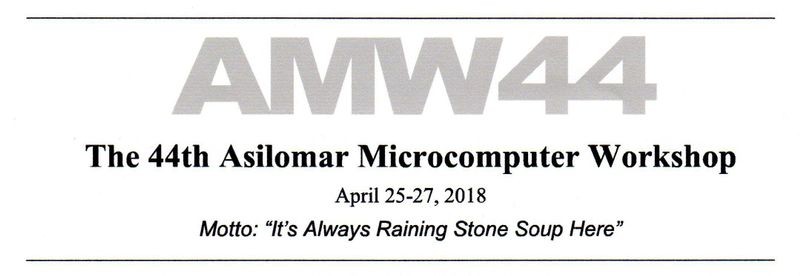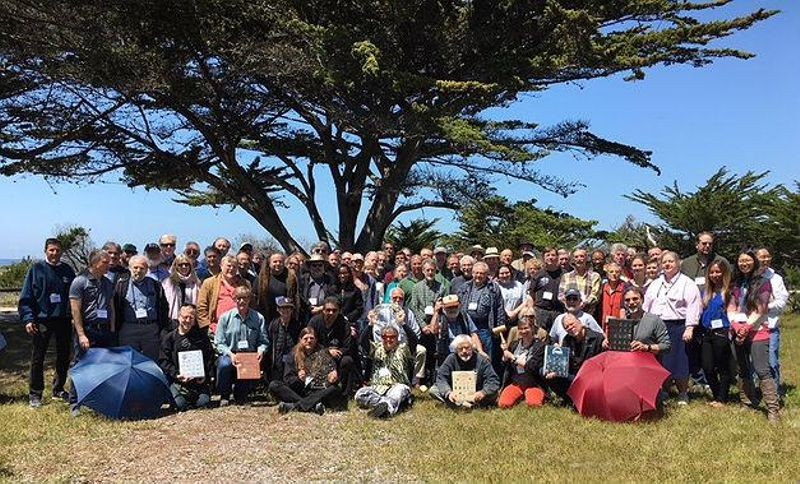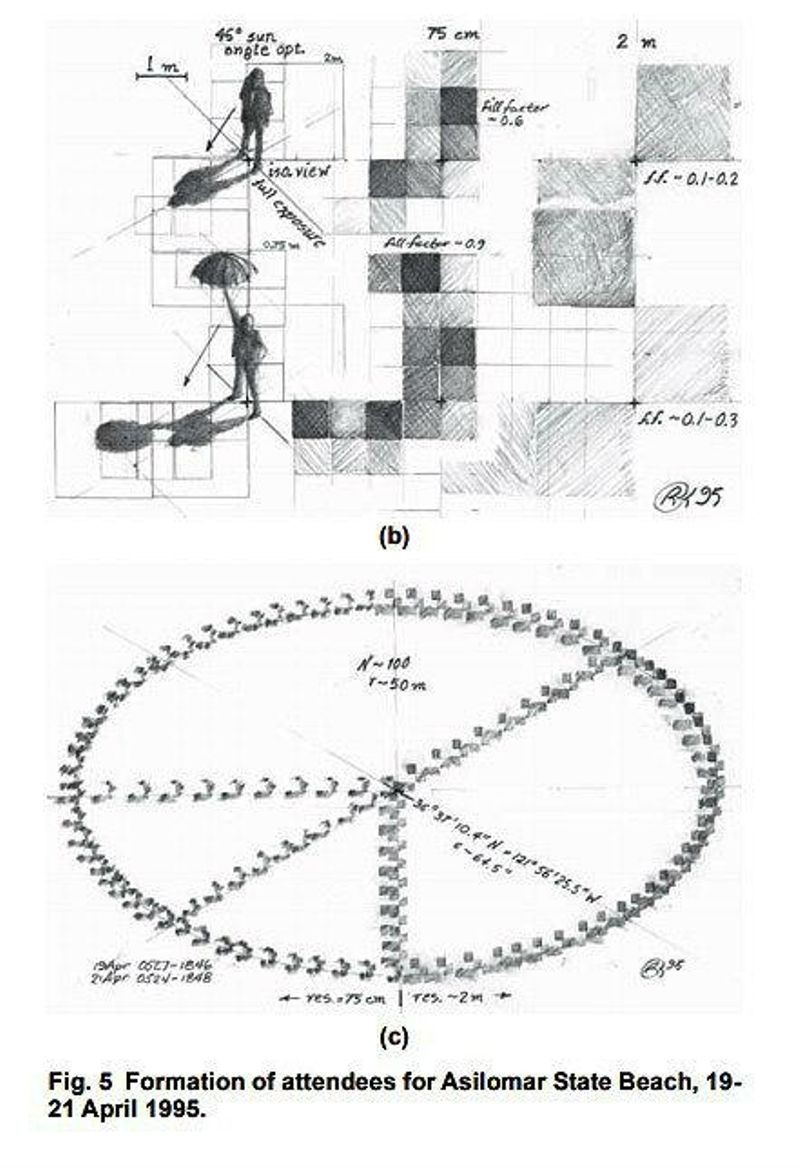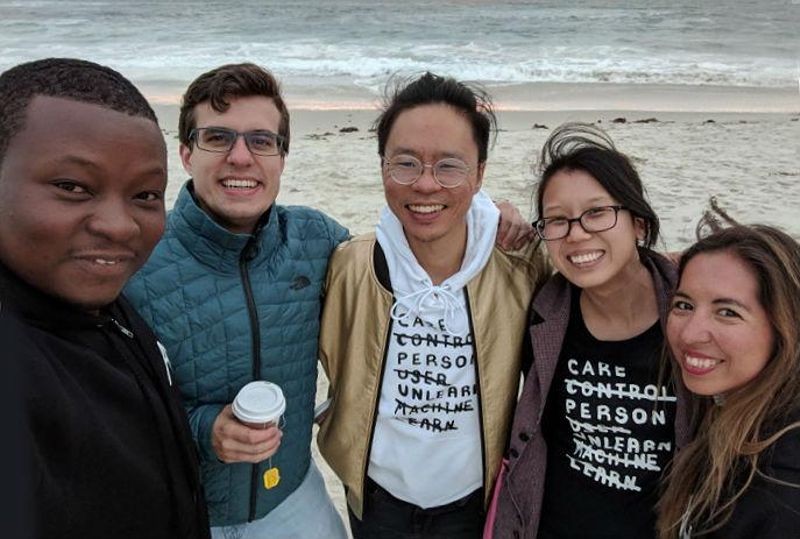

AMW 44 Program header
A microprocessor-embedded Lucite toilet seat and colorful handheld sun umbrellas featured in a group photograph of attendees at the 44th Asilomar Microcomputer Workshop (AMW44) in April 2018 represent the irreverent sense of humor combined with the pursuit of cutting-edge technology and an unrelenting hacker ethic that have pervaded these influential annual meetings of “movers, shakers, nerds, and greybeards of the industry” since 1975.

AMW44 group photo 2018
Meetings, conferences, workshops and other organized gatherings of scientists and engineers have played an important role in advancing and sharing knowledge throughout computer-related technical and business communities for generations. Typically, they are formed to address a specific areas of technology (Wescon, ISSCC, etc.) or products (Comdex, CES, etc.) and thrive for several years until industry focus moves on to new areas of interest.
“Celebrating Microprocessor Technology Since the Dawn of Sand,” the Asilomar Microcomputer Workshop (AMW) held its 44th anniversary in April 2018. This unusually long period of relevance is attributed to a unique format and organizational structure that has allowed AMW to change with the times and remain relevant in an industry noted for its rapid technical and corporate obsolescence.
Large-scale integration of silicon devices, the ability to put thousands of transistors on a single chip, had made the microprocessor computer-on-a-chip a practical system component by the early 1970s. Inspired by the MITS Altair, the first popular microprocessor-based personal computer, a group of pioneers from the semiconductor and burgeoning personal computer industries of Silicon Valley organized a workshop at the conference center at Asilomar State Beach in Pacific Grove, California, in 1975. Their goal: to explore the unique characteristics of microprocessors and identify ways of enhancing their capabilities.
As the microprocessor emerged as an essential building block of the digital revolution, their deliberations over the succeeding decades proved fruitful beyond their wildest expectations. The first popular microprocessor squeezed a couple of thousand transistors onto a piece of silicon a fraction of the size of a finger nail. Today manufacturers routinely put more than one billion transistors in the same space.
In contrast with other technical gatherings, the organizers intentionally eschewed written proceedings and excluded press representatives through an invitation-only attendance policy. This encouraged scientists and engineers from competing companies and institutions across the world to discuss and debate freely issues facing microprocessor designers. Architectural features were born and others aborted during sessions that stretched into the early hours.
Another unique AMW characteristic was required participation by all attendees. Enrollment was limited to about 110 to encourage interaction between participants. First-time attendees generally had to convince the organizing committee that they had something to contribute by speaking at one of the sessions or ad hoc discussion groups. If it was apparent that someone was there only to listen, they might not be invited to return the following year.
Relative to other computer-related gatherings, AMW has attracted a significant contingent of women to its organizing committees. Computer scientist Marianne Mueller served as general chair for many years. This year, Mary Eisenhart, known for her role as forum moderator on the Grateful Dead website, who also served as general chair finally handed her well-pounded RATS gavel over to the younger generation, in the person of Kathleen Tuite. Recent sessions have featured the late cyber-security expert Becky Bace and Air Force “tech-geek, author, and change agent” Lt. Colonel Jennifer Snow.
As microprocessors grew to play a dominant role in the personal computer business and the succeeding digital revolution, larger and more corporate-driven technical conferences took over many of the original goals of AMW. Session topics became focused on applications enabled by the newest generations of processors, rather than features of the chips themselves. By the 30th workshop, Fred Coury, one of the founding organizers, suggested that the gathering could be more aptly described as the “Asilomar Workshop on Neat Stuff.”

AMW sweatshirt logo
Recent topics have included: “Unintended Energy Consequences of Bitcoin Mining,” “Art, Play & Learning,” “The Search for Useful Data on a Scientist’s Farm and Apiaries,” “Exploration of Passing Interstellar Asteroids,” “The Human Side of Robot Cars,” and “Emerging Disruptive Technologies and Self-Regulating Communities.”
A few attendees have disparaged the transition from a specific technological focus to an event that included many socially-oriented topics. Others felt that this change facilitated exploration of the wider implications of technology, and indeed it has allowed the workshop to continue to attract new generations of attendees.
By late 1974, microcomputers, the contemporary name for low-cost computers built around microprocessor-based central processing units, were beginning to appear in small businesses applications and hobbyist gatherings such as the recently founded Home Brew Computer Club. Recognizing their potential importance, four enthusiasts from the San Francisco Bay Area (Fred Clegg, Fred Coury, Ted Laliotis, and Don Senzig) organized a technical workshop sponsored by the Western Area Committee of the IEEE Computer Society. They met at the state-owned Asilomar Conference Center overlooking the ocean in Pacific Grove for its proximity to the Bay Area, yet isolated from the immediate demands of business.

Hearst Social Hall, Asilomar
Session topics at the first meeting in April 1975 ranged from limitations of current chips to microcomputers of the future. There were many limitations. The fastest microprocessor operated at 0.5 MHz clock rate, a 4K RAM was the largest semiconductor memory, PCs existed only in hobbyist kit form, and communication was over 300-baud telephone modems.1
Of the 73 attendees, many went on to play important roles in driving technology beyond these primitive beginnings. Ed McCluskey founded the computer science program at Stanford University. Justin Rattner became CTO responsible for leading Intel’s microprocessor, communications and systems technology labs and Intel Research. Gary Kildall, who had recently founded Digital Research Inc. to promote sales of his ground-breaking CP/M microcomputer operating system, lived within walking distance of Asilomar, and he credited the workshop with having an impact on his success. Vincenzo Torresi cofounded pioneering computer retailer Businessland and other technology companies. Representatives from competing microprocessor vendors AMD, Fairchild, Intel, National, Rockwell, TI, and others rubbed shoulders for the three days of intensive discussions.
AMW expanded to 94 attendees in 1976. Chuck House, coauthor of the HP Phenomenon, the story of innovation and business transformation fostered by the founders of Hewlett-Packard, described Asilomar as a “prestigious venue” for his team to present the ideas behind their new logic state analyzers. Stimulated by their approach, Professor Carver Mead of the California Institute of Technology bounded to the podium and, in a typical AMW moment, proceeded to sketch on House’s presentation foils his thoughts on a revolutionary chip design methodology that would appear in the 1979 book Introduction to VLSI Systems, cowritten by Mead and Lynn Conway. According to House, “AMW would feature many key contributors to this new paradigm over the next few years.”2
A notable session in 1978 on “New Chip Architectures” previewed the next generation of microprocessors that would advance the personal computer from games and simple tasks into serious professional applications. Len Shustek, now chairman of the Computer History Museum (CHM), reviewed “16-bit Microprocessor Architectures” alongside presentations from Intel (8086) and Zilog (Z8000) on their first 16-bit devices.
The last IEEE-sponsored workshop in 1980 featured a rich program of Silicon Valley nobility. Jim Clark of Stanford University spoke on the geometry engine that kick-started Silicon Graphics. RISC pioneer Dave Patterson of UC Berkeley covered “Single Chip Computers of the Future,” a topic that evolved over the subsequent year and led to his 1981 “The RISC” talk. In 2018 Patterson shared the Turing Award with John Hennessy of Stanford for their work on RISC architecture. Gary Kildall, who both influenced and was influenced by discussions at the workshop, described his PL/I compiler. Designer of the first planar IC and the first MOS IC, Bob Norman talked about applications of VLSI. Carver Mead capped this off with a keynote talk on his design methodology.
Although open discussion sessions had long been a staple of AMW, 1981 saw the first such session under the name “A Rich Asilomar Tradition.” Described as “a free for all session in which you have the opportunity to say those things which you would regret in other contexts,” the title was quickly abbreviated to the RAT Session (RATS) by Jim Warren, political activist and founder of the West Coast Computer Faire. (Warren donated his documents related to AMW meetings from 1977–1997 to the CHM collection.) RATS remains an integral aspect of the Asilomar experience.
Founder of MicroDesign Resources (MDR), Michael Slater attended AMW for many years and was a member of the organizing committee from 1985 to 1996. At the April 1987 gathering he announced his plans to begin publishing the Microprocessor Report newsletter. The first edition appeared in September 1987. The newsletter and associated events such as the Microprocessor Forum became widely respected as independent sources of information on this highly competitive and fast-changing sector of the semiconductor industry. Although Slater sold the business in 1990, the newsletter continues in publication today. CHM holds a run of the report from 1987 through 2011.3
Registrants at Microprocessor Forum meetings from 1990 through 2000 received a binder folio of conference notes with chips from microprocessor vendors mounted under a Lucite window on the cover. Pondering how to dispose of unused chips Slater conceived a “billion dollar” toilet seat and cover to represent the vast R&D investment that went into the industry annually, much of it being spent on products that were ultimately unsuccessful, and essentially “flushed down the toilet.” He spent several months experimenting with various materials and molds before producing the artifact that became notorious after appearing in a photograph with Andy Grove and Gordon Moore of Intel.

John Novitsky with the seat in 2018
After Michael died in 2016, John Novitsky former Intel chip architect and analyst at Slater’s company, tracked down the seat that had moved with a succession of owners from Australia to Japan and back to the US. Together with other AMW-related artifacts, he included it in the 2018 group photograph as an expression of Slater’s sense of fun, an essential characteristic of the annual workshop. Novitsky estimates that the total R&D cost of all the microprocessor projects represented by the embedded chips is “roughly $10 billion.” He donated the seat to the Museum collection in July 2018.
A National Securities Studies graduate, Robert G. Kennedy III presented his first scholarly paper “Technological Threats to Civil Liberty” at AMW in 1989. His treatise on potentials for a surveillance state enjoyed a standing ovation from the audience, an invitation to attend Hackers, and a personal visit from the FBI. This validation gave him confidence to embark on a mission to hire a Soviet spy satellite to take a group picture on the beach at AMW ’95.

Plan for 1995 AMW group photo on beach
While employed in the offices of the US House of Representatives Subcommittee on Space, Kennedy was involved in a review of high-resolution photography of the Earth’s surface from commercial satellites. At that time the former USSR was offering competing imagery using Soviet-era spy technology. Kennedy accepted the challenge of pursuing complex negotiations involving the government bureaucracies and security agencies of both nations to hire the Russian service to take a group photo of the attendees standing on the beach in the formation of a peace symbol at the 1995 AMW.4 The sun umbrellas in the 2018 annual photo were intended to throw shadows that would help sharpen the image for publication in the New York Times.
Political machinations conspired to cancel the project at the last minute but it is remembered as a classic example of hacker culture as defined by the late computer guru Bob Bickford: “A hacker is any person who derives joy from discovering novel ways to circumvent limitations.”
Microprocessor architecture is now the province of giant corporations and nation states, rather than the dreams of long-haired nerds in Silicon Valley garages. But as they continue to invade every facet of modern life, microcomputer applications will provide new opportunities for AMW participants to explore for decades to come.

Speakers on technology in Africa and Creative Computing at the 2018 workshop. Photo: Taeyoon Choi.
If heeded, calls at this year’s meeting to make the sessions welcoming to a younger and more diverse audience could help the AMW tradition survive as one of the longest continuous high-tech gatherings into the second half of this century.
*NOTE: This blog was updated on December 1, 2023, to include Lynn Conway as coauthor with Carver Mead of the 1979 book Introduction to VLSI Systems.